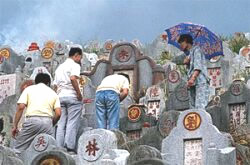 |
Tomb
Sweeping Day |
The Chinese festival of Qing Ming, observed two weeks after the vernal equinox, is in its orgin a celebration of spring. The name means “clear brightness”, and in the past would have been observed with dancing, singing, picnics and kite flying. Boiled eggs would be decorated and broken to symbolise the opening of life, and in the capital, the Emperor planted trees to celebrate the rebirth of nature.
Like many people, the Chinese believe that death is not the end of life, and that the ancestors live on as protectors of the family. Thus, over time, Qing Ming became an opportunity to renew this relationship, and the festival also came to be known as “Tomb Sweeping Day.”
If at all possible, families will gather together and visit the ancestral gravesite or hall of remembrance. The tombs are tidied, dirt swept away, and the ancestors will be honoured with offerings of incense and food. Token goods of paper—money, clothing, even luxury items such as watches and boats—will be transferred to the dead through ritual burning; it is also common for “bank of hell” money to be burnt at the same time in an attempt to distract evil spirits away from the gifts intended for the ancestors.
The ancient tradition of flying kites continues, a ritual believed to bring luck and long life. In the 10th century someone thought to add a tube of bamboo to the kite, thus creating a sound similar to that produced by the zheng, a type of musical instrument.
Chinese
who find it difficult to return to the ancestral burial place might observe
the day by visiting a park, planting trees and even burning paper money
in the street. It is also considered the right occasion for eating chun
juan, spring rolls.